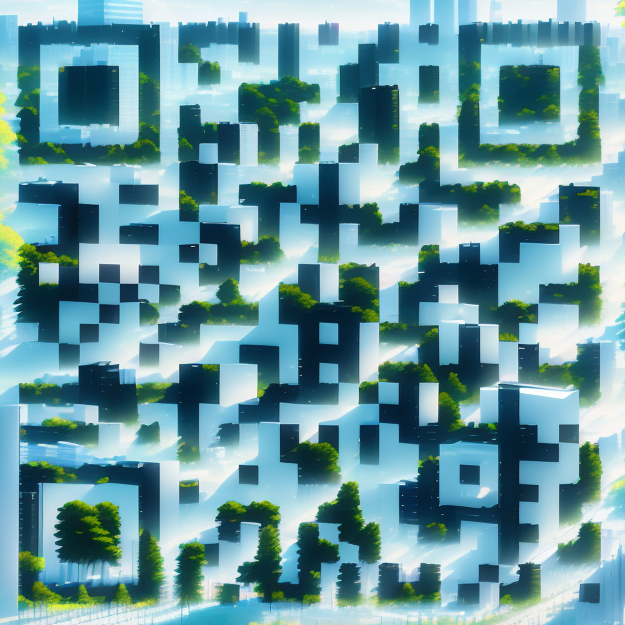来自ASLA对gooood的分享。
Denny Regrade Campus | Site Workshop
项目陈述
Project Statement
本项目的一个关键目标是将城市企业园区重新构想为公共开放空间,使其成为未来健康工作场所的典范,并鼓励办公区域与社区之间建立连接。项目坐落于西雅图Denny Regrade社区,其有利的位置、发达的零售业、丰富的公共艺术、公园、户外座椅、绿色基础设施、多模式交通、灵活的广场和草坪区以及温室空间,共同让园区成为了员工、市中心居民以及寻求独特体验的游客的理想目的地。
“城市植物园”是该设计的核心,多样的植物种类提供了栖息地和赏玩的乐趣。园区中包含建筑内部的花园和屋顶花园,其中最独特的要数“The Spheres”,一个可供公众使用的、专注于保护与教育的温室。绿色的“草原”屋顶创造了欣欣向荣的生态系统,具有生物多样性的本地种植吸引了不同种类的传粉者。一系列植物和景观元素(如在现场发现的树桩和冰川漂砾)有助于构建高质量的公共空间,展现太平洋西北地区的自然特征。基础设施容纳了市场和户外零售座位区,带来一个亲切友好且不断变化的目的地。
Reimagining the urban corporate campus as a public open space is key to the vision for this project, a model for the future of healthy workplaces that encourage connection between the office and the community. The central location in Seattle’s Denny Regrade neighborhood, thriving retail, public art, a dog park, outdoor seating, green infrastructure, multi-modal transit, flexible plazas and lawn areas, and a conservatory make the campus a destination for workers, downtown residents including families, and tourists seeking a unique experience.
The concept of an urban arboretum was central to the design, with a diverse plant palette providing habitat and delight. The campus includes indoor and roof gardens in buildings including The Spheres, a publicly accessible conservatory focused on conservation and education. Green “prairie” roofs create thriving ecosystems where biodiverse native plants attract pollinators. The variety of plants and features like a stumpery and glacial erratics found on the site contribute to high-quality public space that embodies Pacific Northwest nature. Infrastructure that accommodates markets and outdoor seating for retail create a welcoming, ever-changing destination.
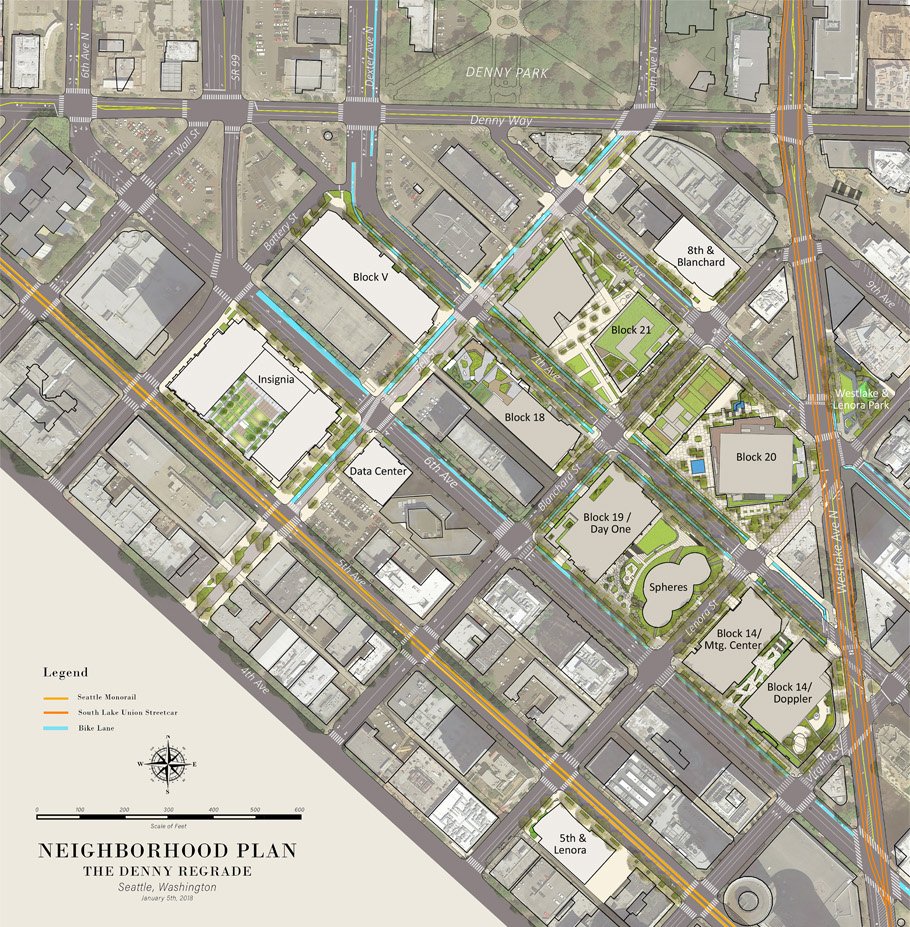
▲Denny Regrade园区场地平面:每个街区都为附近的公共开放空间做出了贡献,包含广场、口袋公园、交通连接、自行车基础设施、遛狗公园,以及沿Blanchard延伸的绿色街道和Lenora的共享街道。Denny Regrade Campus Site Plan. Each block of the Denny Regrade Campus contributes to the public open space of the neighborhood, including plazas, parcel parks, transit connections, bicycle infrastructure, a dog park, green streets along Blanchard, and a shared-use street on Lenora. ©Site Workshop
项目说明
Project Narrative
Denny Regrade园区包括Denny三角的几座城市街区。每个街区都为该社区的公共开放空间做出了贡献,涵盖广场、口袋公园、交通连接、自行车基础设施、遛狗公园、沿Blanchard延伸的绿色街道以及Lenora的共享街道。项目愿景的关键在于将城市企业园区重新构想为一个公共的开放空间,使其成为未来健康工作场所的典范,在日益虚拟化的办公场景下增强实地办公的连接感。在西雅图Denny Regrade社区的中心位置,该园区成为了工人、市中心居民以及游客们的目的地。
“Doppler”是Rufus 2.0开发项目(包含三个街区)中最先完工的街区,该项目标志着亚马逊新总部在西雅图Denny三角的建立。这座37层高的塔楼为城市企业发展建立了高标准,尤其强调高质量的公共开放空间、充满活力的零售环境、多式交通、对人和宠物友好的设施以及公共艺术。该项目还设计并建造了市中心首个分层式的自行车道,在当地社区和西雅图市中心之间建立了重要的连接。
“Day One”是Rufus 2.0开发项目中第二个完工的街区,其特色体现在“球体”(The Spheres)和一个面积超过半英亩的公共开放空间,其中包含一个自由的遛狗公园、带人工草皮的运动场以及一系列聚集空间,公众们可以充分地逗留并享受这些设施。特别值得注意的是户外种植区在园艺方面的多样性:延续“球体”内部丰富的植物收藏,户外种植区为公众与植物爱好者创造了平时难以遇见的体验。
20号街区也被称作“花园街区”,包含了Denny Regrade园区内所有街区中最多的开放空间。在面向“球体”和第七大道的方向,坐落着由当地雕塑家Gerry Tsutakawa创作的标志性水景。郁郁葱葱的植物为座位区创造了柔和的边界和具有私密性的缓冲带,这些座位区均配有定制家具,给人带来户外客厅般的感受。广场上的人行通道从街区中穿过,通向第二处水景。该水景从木模混凝土材质的平台以层叠的方式伸入水池,池中可以看见挖掘过程中发现的几块巨大的冰川漂砾。
“球体”的灵感源于植物学探索黄金时期的维多利亚式温室,提供了一种创新的工作场所类型,通过沉浸式的、充满自然气息的环境探寻了室内景观亲生物设计的边界。“球体”内种植有超过4万株植物和400个物种,犹如一座“植物学院”,号召人们保护全世界热带云林中的植物。湿润而凉爽的内部环境令人心驰神往,游客们可以长时间地观察和深入探索丰富的植物展览:既有高达55英尺的挺拔树木,也有小巧玲珑的兰科植物。
“球体”内还包含各种类型的非正式聚集区、餐饮和活动空间,它们和内部景观融为一体,有助于增强员工之间的连接感。一系列沉浸式的植物展示使员工得以融入自然世界,在具有弹性的环境中卸下压力,同时激发自身的好奇心和创造力。
Denny Regrade园区内的“21号街区”在设计上重点关注市场空间。超过半英亩的开放空间朝向街道的交叉口,零售空间排列在街区的室内区域,吸引着人们进入。第7大道的尽端是一片开阔且自由的草坪,其基础设施可同时容纳日间和夜间市场。在第8大道和贝尔街的拐角处,无障碍的爬山通道从17英尺的高度一路延伸至西北边的本地花园。
从地面到屋顶,园区从所有的层面上整合了可持续的设计举措。“城市植物园”的概念构成了种植设计的核心,多样的植物种类和搭配创造出栖息地,带来充满趣味且随四季变化的体验。园区内的一系列建筑包含室内花园和绿色屋顶,尤其是“球体”,一个专注于植物保护和教育的温室,可供所有人参观。绿色的“草原”屋顶创造了欣欣向荣的生态系统,具有生物多样性的本地种植吸引了不同种类的传粉者。场地中还进行对无脊椎动物种群的持续监测,以收集可供未来项目使用的数据。设计团队还特别关注了亲生物性和注意力恢复理论对建筑使用者健康的作用,以及它们在健康工作场所的设计方法上可能产生的影响。
从现场发现的各种植物和独一无二的自然元素,如树桩和冰川漂砾,共同创造出了高品质的公共开放空间。可容纳日间和夜间市场的基础设施,以及餐厅和零售区的户外座位,为当地居民和游客带来了充满变化的休闲目的地。
设计团队希望该项目能够成为未来办公园区的典范,融入市中心的社区,适应不断变化的未来工作模式,通过与自然的联系和无障碍的交通路径促进健康的生活方式,创造对家庭和宠物友好的公共空间,营造社区聚会和活动场所(如市集和音乐表演),并在密集的城市地区为传粉生物提供可以栖息的绿洲。
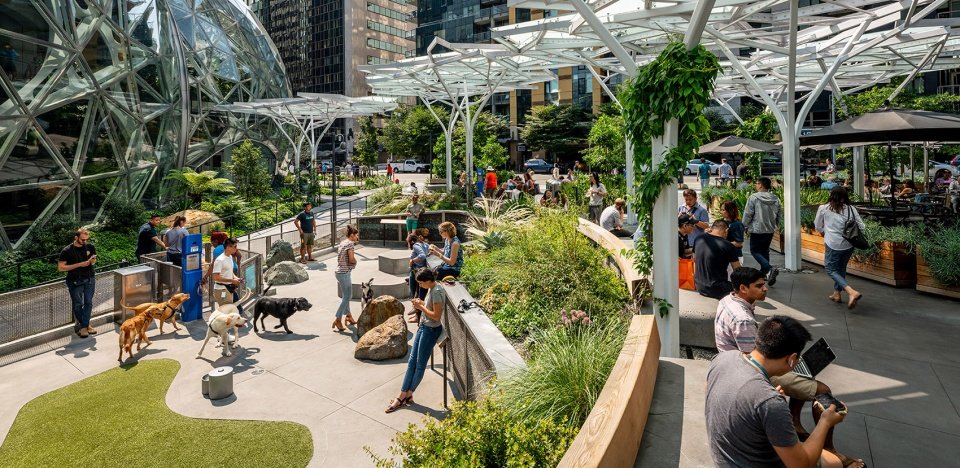
▲不用绑狗绳的公园:公共开放空间包含一个自由的遛狗公园、带有人工草皮的运动场和一系列聚集空间,人们可以停留其中并享受这些设施。Off-leash Dog Park. The publicly accessible open space includes an off-leash dog park, a playfield with artificial turf and numerous gathering spaces where the public is invited into the space to linger and enjoy the amenities.©Stuart Issett

▲快闪集市:灵活的开放空间为各种活动提供了机会,包括集市等。Pop-Up Market. The flexible open space provides opportunities for a variety of events, including markets.©Stuart Issett

▲路权的改善:优化后的道路包含新的自行车道、无障碍铺地和交汇口、座椅以及繁茂的植物和行道树。项目设计并修建了市中心的首个分层式自行车道,在社区与西雅图市中心之间建立了重要的连接。Right-of-Way Improvements. Right-of-way improvements include new bike lanes, accessible paving and intersections, seating, lush plantings and street trees. This project designed and implemented the first block of grade-separated cycle tracks downtown, providing an important link between neighborhoods and the heart of Seattle.©Stuart Issett
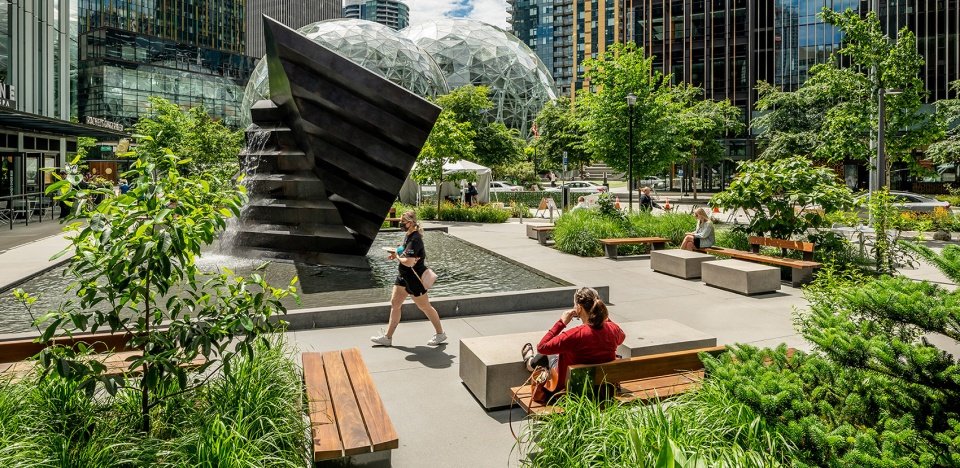
▲公共艺术水景:在面向“球体”和第七大道的方向,坐落着由当地雕塑家Gerry Tsutakawa创作的标志性水景。Public Art Water Feature. The focal piece of the plaza facing the Spheres and 7th Avenue is a signature water feature by local sculptor Gerry Tsutakawa.©Stuart Issett
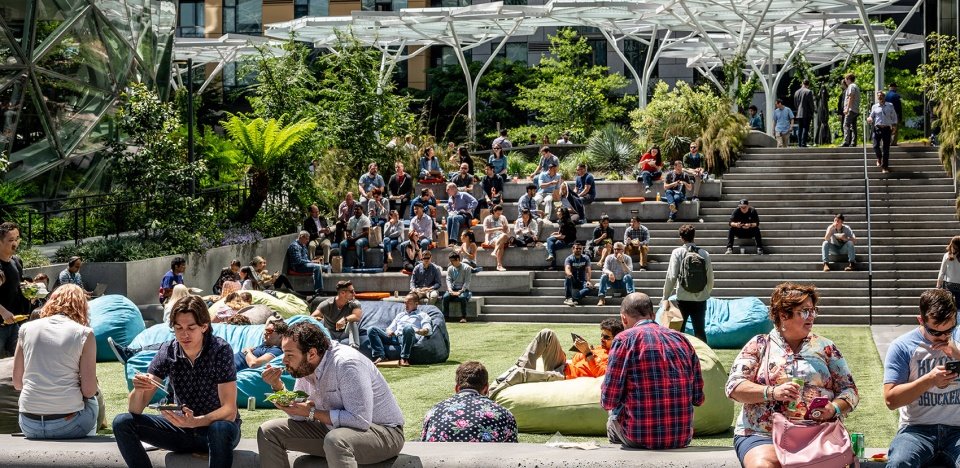
▲灵活的开放空间:园区整体被重新构想为一个充满活力的公共开放空间,为工作、社交、举办活动和户外休闲提供了精心设计的环境。Flexible Open Space. The corporate campus has been reimagined as a vibrant public open space, with thoughtfully designed areas for working, socializing, events, and enjoying a sunny day.©Stuart Issett
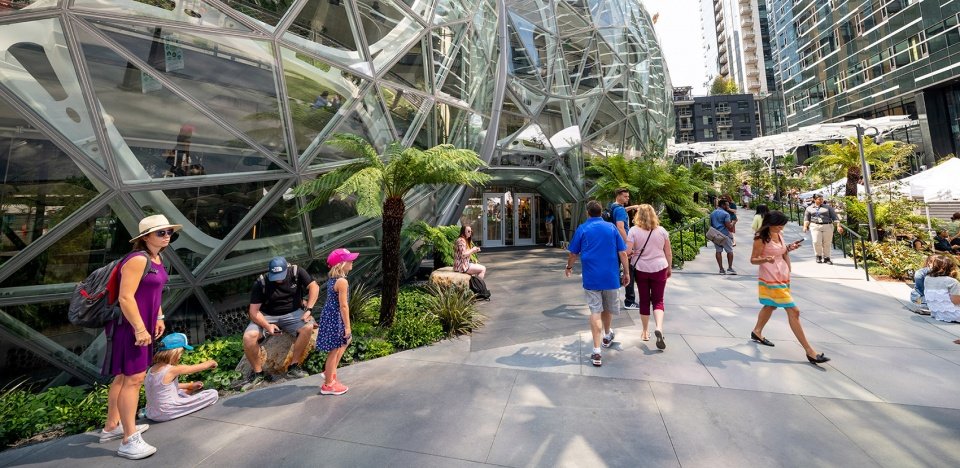
▲稀有的植物品种:“球体”的外部空间创造了意义非凡的植物体验,各种稀有植物和当地不常见的物种为普通公众和植物爱好者们提供了特殊的享受。Rare Plant Species. The exterior planting at the Spheres creates a botanically meaningful experience on its own, with a variety of rare and locally uncommon plant species that offer a special treat for the general public and plant nerd alike.©Stuart Issett
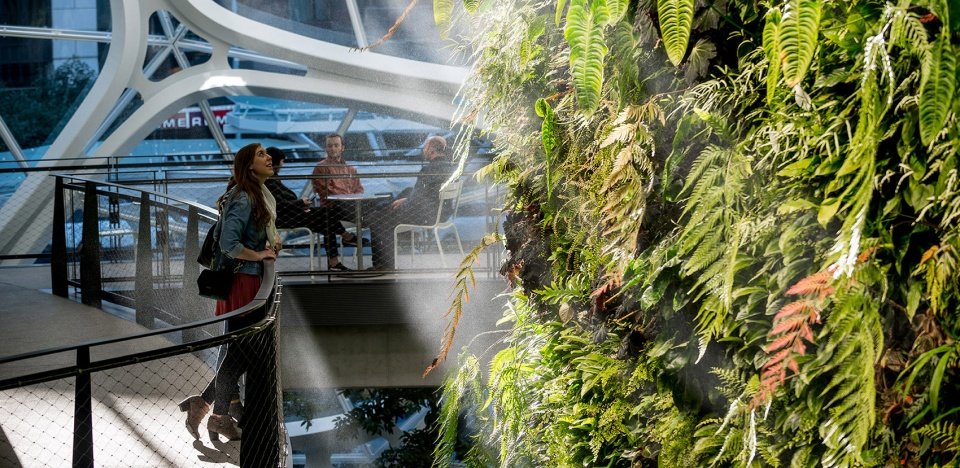
▲生态绿墙:面积为3200平方英尺、高度为67英尺的生态绿墙包含150多个物种和2万5千多株植物。创新的生态墙系统支持广泛的植物多样性,并具有远程检测和控制功能,以确保长期持续。Living Wall. The 3200-SF, 67’-tall living wall features more than 150 species and more than 25,000 individual plants. The innovative living wall system supports a wide range of plant diversity and includes remote monitoring and controls to ensure long-term success.©Stuart Issett
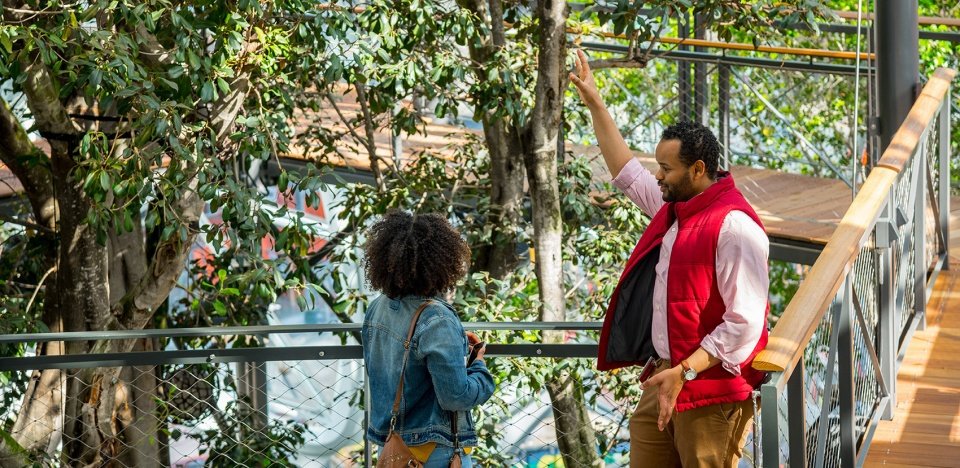
▲亲生物的室内景观:创新的工作场所类型以沉浸式的、富于自然的环境为基础,探寻了室内景观亲生物设计的边界。“球体”犹如一座植物学院,囊括了超过4万株植物和400个物种,并突出展示了来自热带云林的植物。Biophilic Indoor Landscape. This innovative workplace typology based in an immersive, nature-rich environment tests the limits of biophilic design for interior landscapes. Home to more than 40,000 plants and 400 species, The Spheres is a botanical institution emphasizing plants from tropical cloud forests.©Stuart Issett
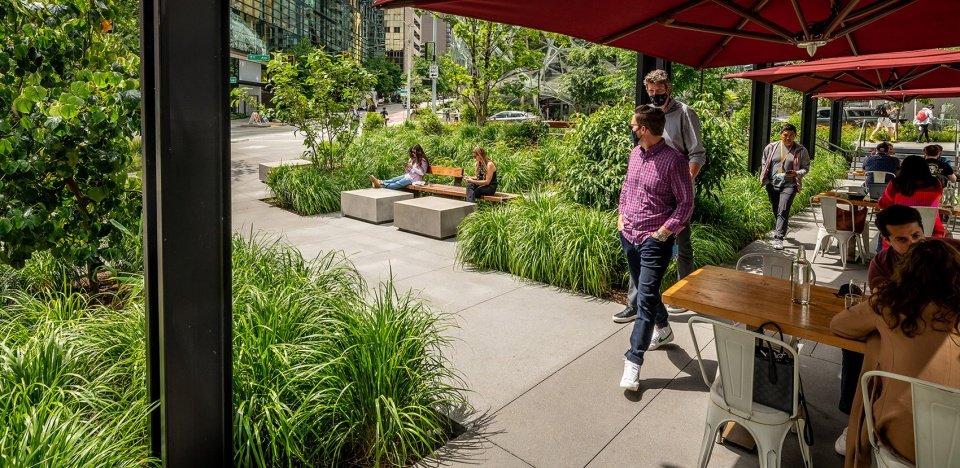
▲被零售空间激活的边缘:园区建筑边缘的公共空间通过零售空间被赋予了活力,包括一些标志性的当地餐厅和商店。Retail-Activated Edge. Retail including iconic local restaurants and shops activate the public spaces along the edge of the campus buildings.©Stuart Issett
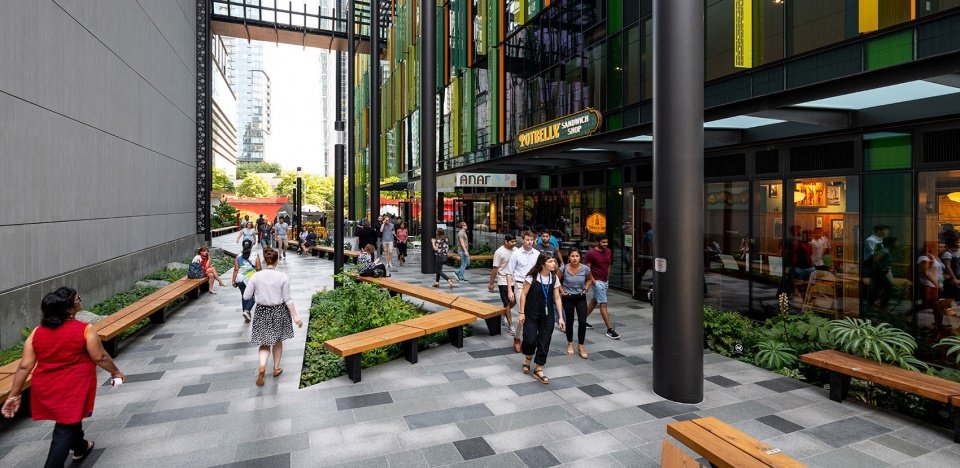
▲步行目的地:带顶棚的广场为建筑物之间的零售区域提供了座位和界面。Pedestrian Destination. A covered plaza provides seating and frontage for retail and restaurants between buildings.©Stuart Issett
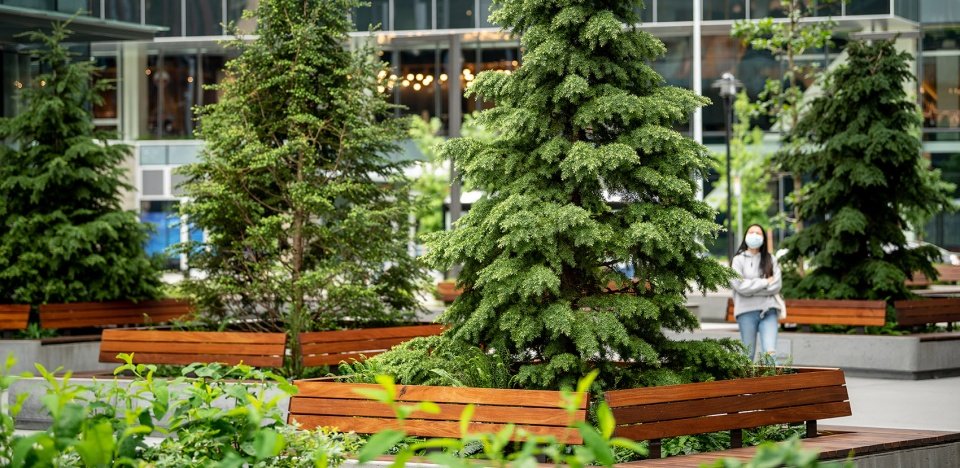
▲针叶树木种植池:大型的针叶树使人联想到太平洋西北地区的森林,并为户外座位提供了背景。在整个项目中,一系列沉浸式的植物展示使员工得以融入自然世界,在具有弹性的环境中卸下压力,同时激发自身的好奇心和创造力。Conifer Planters. Large conifers evoking Pacific Northwest forests provide backdrops for outdoor seating. Throughout the project, a variety of immersive planting displays engage employees in the natural world, creating a restorative environment that relieves stress, invites curiosity and sparks creativity.©Stuart Issett
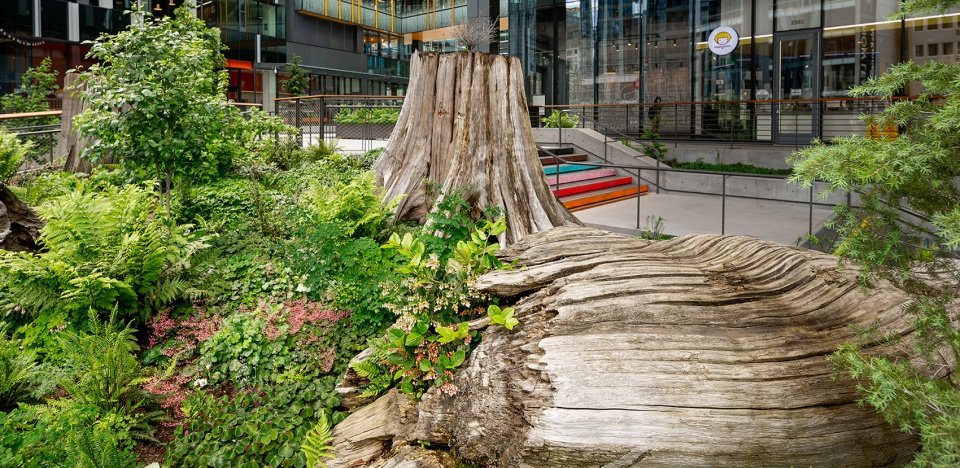
▲树桩:多样的植物和景观小品,如现场发现的树桩和冰川漂砾,展现了太平洋西北部的自然特征,有助于营造高质量的公共开放空间。Stumpery. The variety of plants and features like a stumpery and glacial erratics found on the site contribute to the high-quality public open space that embodies Pacific Northwest nature.©Stuart Issett
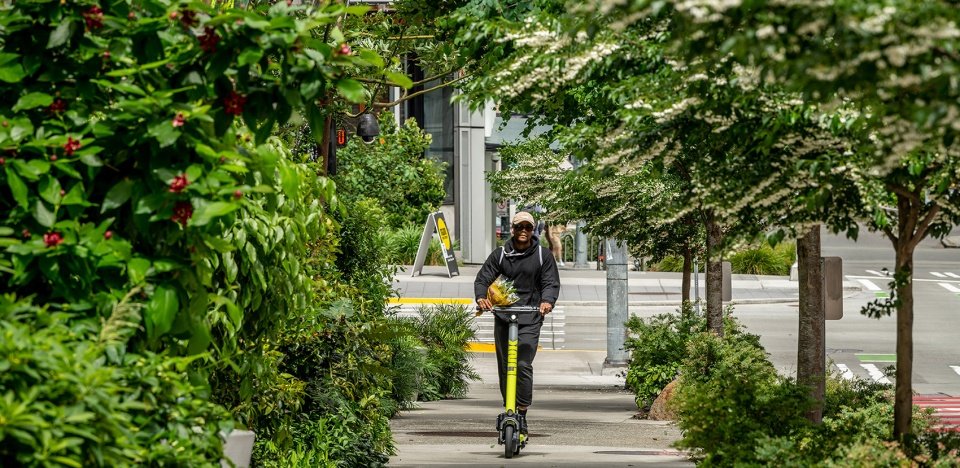
▲行道树:葱郁的花坛和行道树为园区创造了一个诱人的入口。植物搭配方案旨在实现全年变化的季节性景致。Street Trees. Lush planting beds and street trees create an inviting entry to the campus. The plant palette has been designed to provide year-round seasonal interest.©Stuart Issett
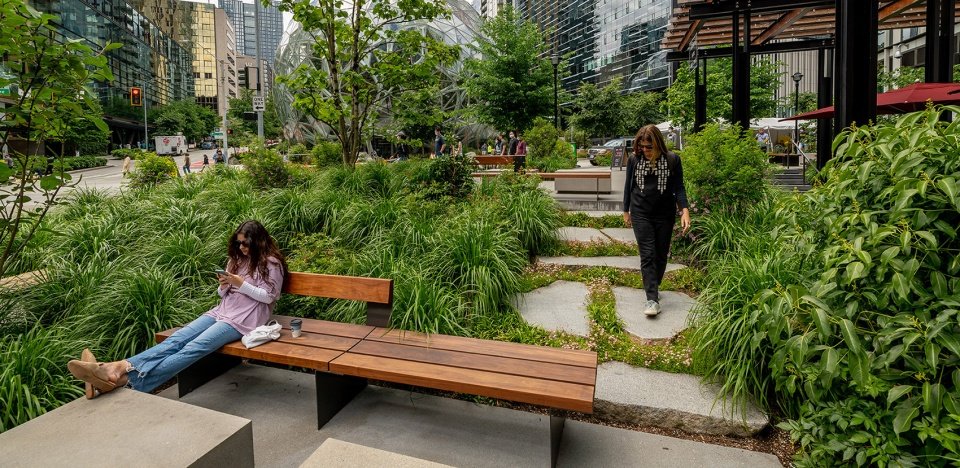
▲亲生物的户外空间:计团队还特别关注了亲生物性和注意力恢复理论对建筑使用者健康的作用,以及它们在健康工作场所的设计方法上可能产生的影响。Biophilic Outdoor Rooms. The design team is especially interested in the role of biophilia and attention restoration theory on the health of the building occupants and local community, and the potential for transforming the way that we approach the design of healthy workplaces.©Stuart Issett
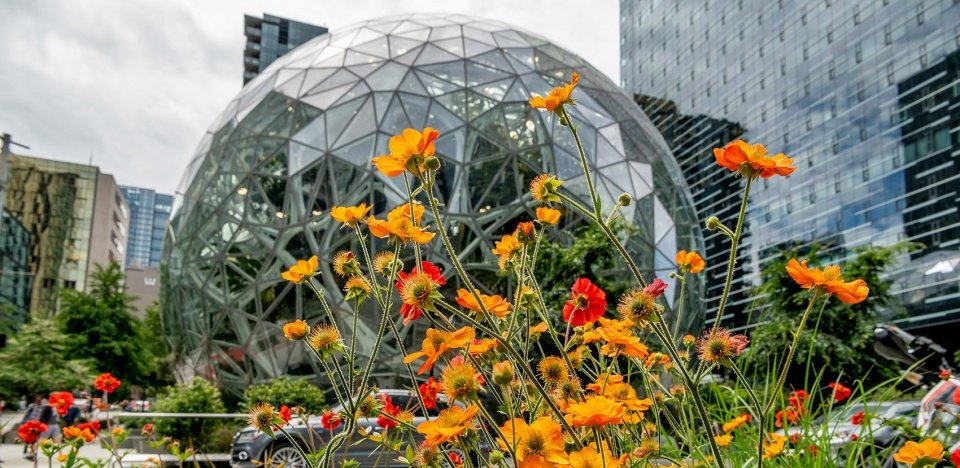
▲传粉生物的绿洲:设计团队希望该项目能够成为未来办公园区的典范,融入市中心的社区,适应不断变化的未来工作模式,促进健康的生活方式,营造社区聚会空间,并为传粉生物提供可以栖息的绿洲。Oasis of Pollinator Habitat. We hope that this project is a model for the future office campus that is integrated into downtown communities, adaptable to a changing future of work, promotes healthy lifestyles, provides community gathering spaces, and is an oasis of pollinator habitat.©Stuart Issett
Project Narrative
The Denny Regrade Campus includes several urban blocks in the Denny Triangle neighborhood. Each block contributes to the public open space of the neighborhood, including plazas, parcel parks, transit connections, bicycle infrastructure, a dog park, green streets along Blanchard, and a shared-use street on Lenora. Reimagining the urban corporate campus as a public open space is key to the vision for this project, a model for the future of healthy workplaces that encourage connection at the office in an increasingly virtual work world. The central location in Seattle’s Denny Regrade neighborhood makes the campus a destination for workers, downtown families, and visitors.
Doppler is the first completed project of the three block Rufus 2.0 development marking Amazon’s new headquarters in Seattle’s Denny Triangle neighborhood. This 37-story tower sets a high standard for urban corporate development, with a strong emphasis on high-quality public open space, a thriving retail environment, multi-modal transit, pedestrian- and dog-friendly amenities, and public art. This project also designed and implemented the first block of grade-separated cycle tracks downtown, providing an important link between neighborhoods and the heart of downtown Seattle.
The second of the three block Rufus 2.0 development, Day One is highlighted by the Spheres and over a ½ acre of publicly accessible open space including an off-leash dog park, a playfield with artificial turf and numerous gathering spaces where the public is invited into the space to linger and enjoy the amenities. Of particular note is the horticultural diversity of the exterior planting areas. Picking up on the diverse collection inside the Spheres, the exterior plantings offer a special treat for the general public and plant nerd alike.
Block 20, nicknamed the “Garden Block”, contains the most open space of any block in the Denny Regrade campus. The focal piece of the plaza facing the Spheres and 7th Avenue is a signature water feature by local sculptor Gerry Tsutakawa. Lush plantings create a vegetated edge and privacy buffer for seating areas with custom furnishings that feel like outdoor living rooms. A pedestrian connection from the plaza leads through the block to a second water feature that cascades over board-formed concrete into a pool with several large glacial erratics discovered at the site during excavation.
Inspired by the Victorian conservatories from the golden age of botanical exploration, The Spheres offers an innovative workplace typology based in an immersive, nature-rich environment that tests the limits of biophilic design for interior landscapes. Home to more than 40,000 plants and 400 species, The Spheres is a botanical institution in its own right, emphasizing the conservation of plants from the world’s tropical cloud forests. The humid yet cool interior environment is both welcoming and refreshing, inviting extended visits and in-depth exploration of intensive planting displays that include trees as large as 55′ tall alongside orchids that fit on a fingertip.
With a variety of informal gathering areas, food service and events spaces integrated throughout the building and interior landscape, the Spheres is a place for employees to connect with each other. At the same time, a variety of immersive planting displays engage employees in the natural world, creating a restorative environment that relieves stress, invites curiosity and sparks creativity.
Block 21 on the Denny Regrade campus was designed with a marketplace in mind. Over a half acre of open space faces the street intersections, and retail spaces line the block interior— encouraging people to enter. The 7th Ave end features a large, flexible lawn with infrastructure to accommodate both day and night markets. An accessible hill-climb ascends seventeen feet from the corner of 8th & Bell Streets to an overlook through a northwest native garden.
The campus integrates sustainable features on all levels – from ground to rooftop. The concept of an urban arboretum was central to the planting design, with a diverse plant palette creates habitat and provides moments of interest and seasonal delight. The campus includes indoor and roof gardens in buildings including the Spheres, a publicly accessible conservatory focused on conservation and education. Green “prairie” roofs create thriving ecosystems where biodiverse native plants attract pollinators. Ongoing monitoring of the invertebrate population is being done to collect data that can inform future projects. The design team is especially interested in the role of biophilia and attention restoration theory on the health of the building occupants, and the potential for transforming the way that we approach the design of healthy workplaces.
The variety of plants and features like a stumpery and glacial erratics found on the site are unique and contribute to the high-quality public open space. Infrastructure that accommodates day and night markets and outdoor seating for restaurants and retail create an ever-changing destination welcoming to neighbors and visitors alike.
We hope that this project can serve as a model for the future office campus that is integrated into downtown communities, adaptable to a changing future of work, promotes healthy lifestyles through connection to nature and accessible people-powered commuting, is family- and dog-friendly, provides community gathering spaces and places for events like markets and live music, and is an oasis of habitat for pollinators in a dense urban area.
More:ASLA;Site Workshop
